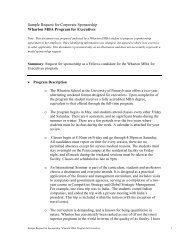wharton's prescription for health care - Wharton Magazine
wharton's prescription for health care - Wharton Magazine
wharton's prescription for health care - Wharton Magazine
You also want an ePaper? Increase the reach of your titles
YUMPU automatically turns print PDFs into web optimized ePapers that Google loves.
FEATUREFEATUREILLUSTRATION / JONATHAN CARLSONT HEBUSINESSOFHEALTHCARELAST FALL, WHARTON’S HEALTH CARESYSTEMS DEPARTMENT CELEBRATED ITS 25 THANNIVERSARY. FACULTYANDALUMNIHAVELEDTHE EFFORT TO LINK THE DISCIPLINESOF ECONOMICS AND MANAGEMENT TO THEPRACTICE OF MEDICINETo understand why <strong>Wharton</strong>’s <strong>health</strong> <strong>care</strong> management programwas first established in 1970, and why it has been sosuccessful in educating undergraduate, MBA and doctoralstudents, it helps to know some of the history.For example:■ In 1965, the year Medicaid and Medi<strong>care</strong> were passed,<strong>health</strong> <strong>care</strong> represented six percent of the Gross DomesticProduct. Today, it is a trillion dollar industry — the largestin the nation — totaling 13.9 percent of GDP.■ In 1967, the Leonard Davis Institute of Health Economicswas established with a gift from Leonard Davis, founderof Colonial Penn Insurance Co. LDI’s mission was, and is,to serve as a multidisciplinary research institute focused onthe economic, behavioral and public policy aspects of <strong>health</strong><strong>care</strong> delivery and financing.The visionary behind LDI, which is recognized as the precursorto the <strong>health</strong> <strong>care</strong> systems department, was foundingdirector Robert Eilers, professor of insurance at <strong>Wharton</strong>and of community medicine in the School of Medicine untilhis death in 1974 at age 43.“Eilers more than anyone established LDI as a universitywideinstitute specifically with the mission of bridgingmedicine and <strong>Wharton</strong>,” says William Kissick, chairman ofLDI’s governingboard. “And it wasEilers who decided early on that if the institute was going tohave credibility in <strong>Wharton</strong> it had to have an educationalcomponent.” That meant an MBA program — and later undergraduateand doctoral programs — with the specific goal oftraining managers and analysts of <strong>health</strong> <strong>care</strong> systems.■ In 1970, the <strong>Wharton</strong> faculty approved the creation of agraduate <strong>health</strong> <strong>care</strong> management program at <strong>Wharton</strong>. Atthe time, says Mark Pauly, Bendheim Professor of HealthCare Systems and vice dean of doctoral programs at <strong>Wharton</strong>,<strong>health</strong> economics in the minds of Leonard Davis andmany others meant cost containment. The passage ofMedi<strong>care</strong> and Medicaid two years earlier had unleashed thepayment of billions of dollars in state and federal reimbursementsto hospitals and doctors who provided <strong>health</strong><strong>care</strong> to the poor, elderly and handicapped. By 1967, lack ofeffective constraints on these programs had caused <strong>health</strong>relatedinflation to skyrocket.“Health <strong>care</strong> was a non-system,” says Arnold Rosoff, professorof legal studies and <strong>health</strong> <strong>care</strong> systems. “All theelements were functioning separately. The delivery of <strong>care</strong>was not linked to the payment of <strong>care</strong>. Medicine was dom-inated by physicians who had no economics backgroundand no training as managers.”Another area of interest to LDI founders in the late1960s was universal insurance coverage <strong>for</strong> <strong>health</strong> <strong>care</strong>services. Medi<strong>care</strong> and Medicaid together covered about20 percent of the population while private employer-basedcoverage spread rapidly to most employees and their dependents.Yet millions of other Americans who didn’t qualify<strong>for</strong> Medicaid but couldn’t obtain <strong>health</strong> insurance fellbetween the cracks. Although Congress gave serious considerationto national <strong>health</strong> insurance in 1974 and againin 1993, no legislation was approved and universal coverageremains an elusive goal.Last fall, the <strong>health</strong> <strong>care</strong> systems department celebratedits 25th anniversary. Cost containment and<strong>health</strong> <strong>care</strong> <strong>for</strong> the uninsured are still two of the majorchallenges facing the industry, but they have beenjoined by the equally important issues of qualityassurance and technology assessment. Meanwhile,phrases used by <strong>Wharton</strong> planners in 1970 to framethe issues are now common language in the<strong>health</strong> <strong>care</strong> debate: Patients are referred toas consumers of <strong>health</strong> <strong>care</strong>; doctorsand hospitals are referred to asproviders; managed <strong>care</strong> is a relativelynew term that holds outthe promise of controlling <strong>health</strong>costs through the use of provider-targetedincentives and directives.The rationale <strong>for</strong> placing a <strong>health</strong> <strong>care</strong> program in a businessschool — essentially linking medicine to the disciplinesof economics and management — has clearly been justified.“Our program exists because <strong>health</strong> <strong>care</strong> does respond to market<strong>for</strong>ces,” says Patricia Danzon, Celia Z. Moh Professor ofHealth Care Systems, professor of insurance and risk management,and chair of the <strong>health</strong> <strong>care</strong> systems department.“Competitive pressures have become much more aggressiveand management skills have become essential.”T HE ISSUESKissick compares today’s <strong>health</strong> <strong>care</strong> industry to an onion.“Every time you peel something away, there is another layer... and the more you peel, the more layers there are,” he says.“In 1965, I totally understood the American <strong>health</strong> <strong>care</strong>enterprise — its system, the financing, everything. I had myarms around it. I can’t do that today. It is so complex andit is changing so rapidly.”One of the biggest drivers of this change has been theadvent of insurance products with different kinds of incentives<strong>for</strong> the behavior of physicians and patients. These can rangefrom the pre-hospitalization testing that some insurers requireto a staff model HMO where physicians are employees of theplan to an Independent Practice Association (IPA) where physiciansgroups contract with an outside carrier.John Ferry, MD, WG’82, presidentand CEO of SouthamptonHospital in Southampton, NY.Southampton Hospital is a 194-bed community hospital in asemi-rural resort area known asThe Hamptons on Long Island, NY.Because of its location, “we have oneof the wackier staffing and organizationalproblems I’ve heard of,” noteshospital president and CEO JohnFerry, WG’82.Year-round, the population isabout 80,000, consisting mainlyof retirees, farmers, fishermen andservice people <strong>for</strong> the local economy.In the summer, the populationbulges to 300,000, including actorsand actresses, movie directors, WallStreet investors, models and so <strong>for</strong>th.Finally, about a mile from the hospitalis an Indian reservation.If that sounds complicated, thechallenges are only beginning.Southampton Hospital is about tomerge with two others “to allow us tosurvive,” says Ferry, who has beenCEO of the $55 million facility <strong>for</strong>approximately two years. “Be<strong>for</strong>e Icame here, the hospital was losingclose to $3 million a year. Last yearwe lost about $643,000. This yearwe will make a profit. But I don’t feela false sense of security because Ican’t tighten the belt anymore.”Add to that the likelihood that thehospital will take a multimillion dollarhit from Medi<strong>care</strong>/Medicaid re<strong>for</strong>m,“and you can see why economies ofscale” are appealing, he notes.Still unclear is who will be CEO ofthe newly merged entity and where itwill be located — in one or more ofthe existing facilities or on a totallynew site.In the midst of this uncertainty,Ferry, who was trained in medicalschool as a pediatrician, offers somethoughts on <strong>health</strong> <strong>care</strong>:“I have a lot of hope <strong>for</strong> the ideaof provider-sponsored networks,” henotes. These networks, composed ofdoctors and hospitals, would start takingon some of the financial risk ofproviding <strong>health</strong> <strong>care</strong>, “which is whatthe insurance companies are trying toget us to do anyway, except that theywant to take some of the profits.”Working with insurers, Ferrynotes, does have benefits: Insurersoffer marketing, which hospitals“don’t exactly excel at,” and theyoffer in<strong>for</strong>mation systems that areclinical and claims-based, and relatespecifically to physician activity. Thisallows insurers to sift through in<strong>for</strong>mationsystems to come up withtrends, develop profiles on patientsand doctors, and so <strong>for</strong>th.“But the technology is transportable,”Ferry says. “Insurancecompanies don’t have a lock on it.Provider networks could very welldevelop this on their own.”Another implication of these networksis that physicians over 40 whowent into medicine to be their ownbosses will no longer be practicing theway they expected to,” Ferry adds.“Instead, they will work in groups.Also, patients will have less choice,which they will come to expectbecause they will be paying less, andthey will also have to drive farther toget services.“It’s a disruptive scenario, but inthe end will we be much worse off?No, not in terms of what people callmedical <strong>care</strong>. And there may well bepluses, such as an emphasis on outcomesmeasurement, which meansthat as physicians we can no longersay we are doing a good job, we haveto prove it .”“Back in 1970, cost containment looked like an insuperableproblem,” says Pauly. “But with the spread of managed<strong>care</strong>, there seems to be evidence that costs are, at the very6W INTER 19967WHARTON ALUMNI MAGAZINE
















